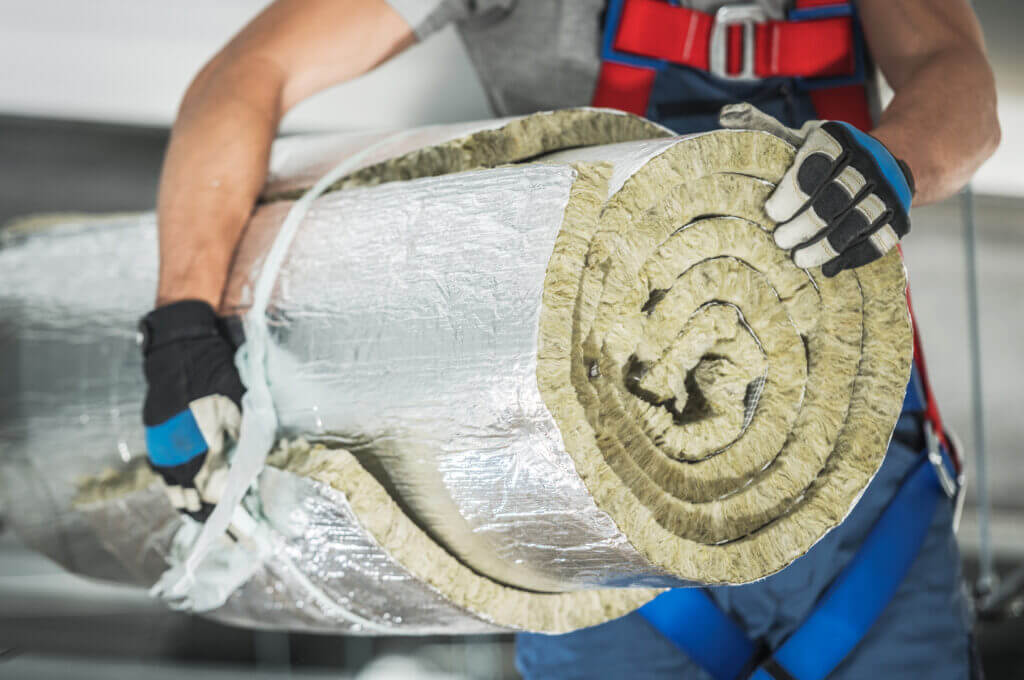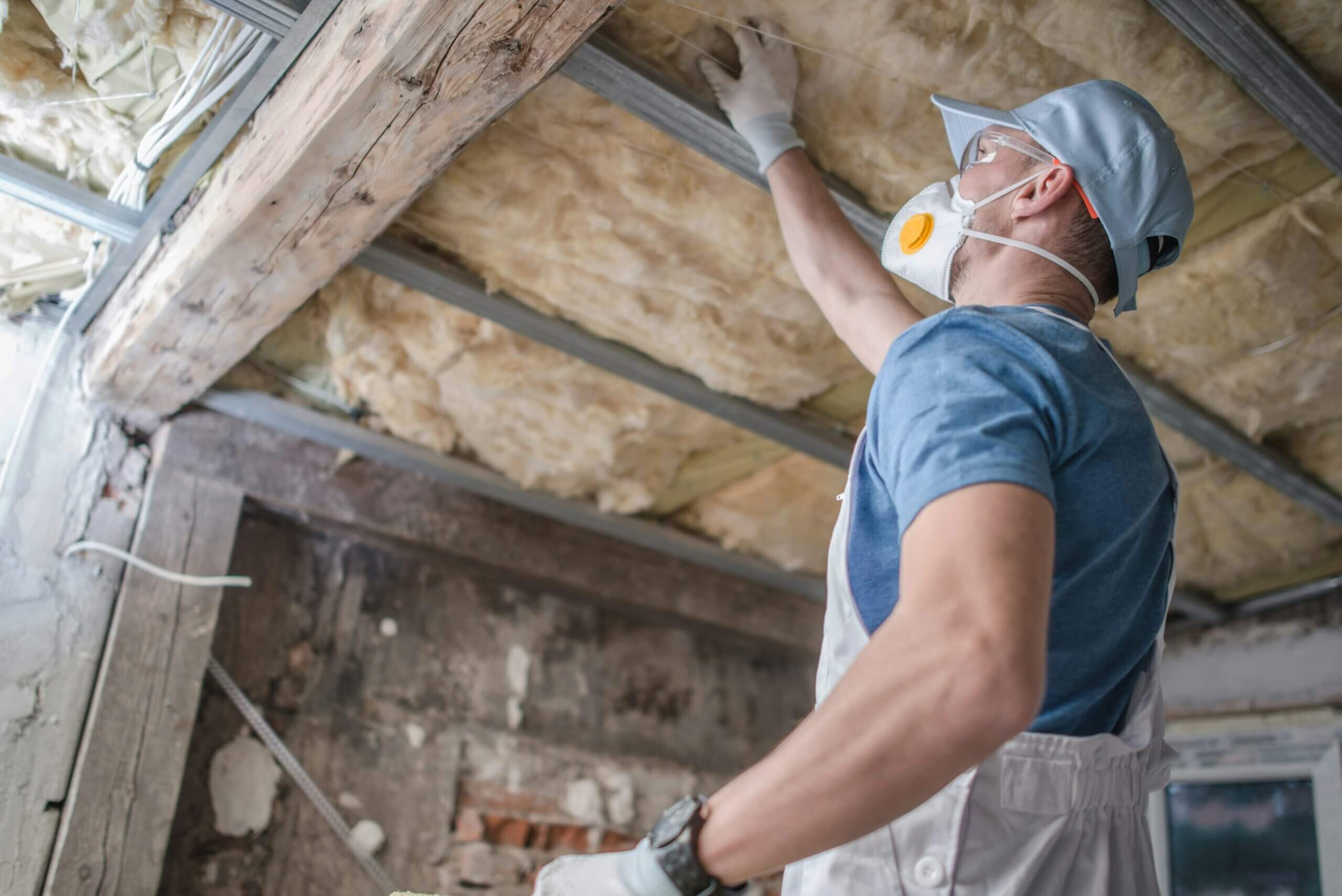What Is Insulation?
Home insulation is one of the best ways to make your home more energy-efficient and comfortable year-round. Quality insulation acts like a barrier. It keeps warm air inside during the winter and blocks heat from entering during the summer. By helping your home maintain a steady temperature, insulation reduces energy use, lowers utility bills, and minimizes drafts and cold spots.
Insulation is typically installed in key areas of your home, including walls, ceilings, floors, attics, and basements. The goal is to prevent heat from escaping or entering where it shouldn’t. Common insulation materials include:
- Fiberglass
- Cellulose
- Spray Foam
- Mineral Wool
- Rigid Foam Boards
Each material has its own benefits when it comes to thermal resistance (R-value), ease of installation, and durability.

Frequently Asked Questions
How Does Insulation Work?
Home insulation works by slowing down the movement of heat, helping your home stay warm in the winter and cool in the summer. It traps small pockets of air within the material. These pockets slow down the transfer of heat, helping to keep your indoor temperatures stable no matter what the weather is like outside.
Here are the three key ways insulation helps:
- Thermal Resistance (R-Value): Insulation materials are rated by their R-value, which measures how well they resist heat flow. The higher the R-value, the better the insulation performs at keeping heat in or out.
- Air Sealing: Insulation also works with air sealing to block drafts. By sealing gaps and cracks around windows, doors, electrical outlets, and ductwork, it prevents air leaks that can drive up your energy bills.
- Reflective Barriers: In warmer climates, reflective insulation can be added to reflect heat away from your home. This extra layer helps reduce indoor heat buildup and keeps cooling costs down.
The most effective insulation systems often use a combination of these methods to maximize energy efficiency and home comfort.
Frequently Asked Questions
Types of Home Insulation: Materials & Installation Methods
These are the most common materials used in residential insulation, each with unique benefits:
- Fiberglass: This is the most widely used insulation material in the U.S. It’s made from fine glass fibers and is an affordable, effective choice for reducing heat transfer. Fiberglass is commonly used in walls, attics, floors, and ceilings. It’s available in batts, rolls, and loose-fill (blown-in) forms. Note: It can cause skin and respiratory irritation if handled without protective gear.
- Cellulose: Cellulose is made from recycled paper products and treated to resist fire and pests. It’s eco-friendly and offers good thermal and soundproofing performance. Cellulose is typically installed as loose-fill using blowing equipment, making it ideal for wall cavities and attic spaces.
- Spray Foam: This is applied as a liquid that expands into a solid foam, creating an airtight seal. It has one of the highest R-values per inch and is perfect for sealing gaps, crawl spaces, rim joists, and hard-to-reach areas. While it costs more upfront, spray foam offers significant long-term energy savings.
- Mineral Wool (Rock Wool): Mineral wool is made from natural rock or recycled steel industry slag. It’s fire-resistant, moisture-resistant, and offers excellent soundproofing. It’s typically available in batts or loose-fill and is used in walls, floors, and ceilings.
- Cotton (Denim) Insulation: Made from recycled denim and cotton fibers, this eco-friendly option is safe to handle and provides good thermal and sound insulation. It’s usually sold in batts and is great for walls, ceilings, and floors.

In addition to the above materials, insulation can come in different forms depending on how and where they’ll be installed:
- Batt Insulation: Batts are pre-cut panels of insulation, typically made from fiberglass, mineral wool, or cotton. They fit between wall studs, floor joists, and ceiling rafters. Batts are easy to install during new construction or remodeling but require careful placement to avoid gaps.
- Roll Insulation: This type of insulation is similar to batts but comes in long, continuous rolls. It’s ideal for covering large, open areas like attic floors and is easy to install in new construction.
- Blown-In (Loose-Fill) Insulation: Blown-in insulation is made of loose fiberglass, cellulose, or mineral wool fibers. It’s blown into wall cavities or attics using special equipment and is great for hard-to-reach or irregular spaces. It’s also a popular choice for improving existing insulation.
- Rigid Foam Board Insulation: Rigid foam boards come in solid panels that can be cut to size and are made from polystyrene, polyisocyanurate, or polyurethane. They’re used to insulate flat surfaces like basement walls, exterior walls, and roofs, providing continuous insulation and reducing thermal bridging. They offer a high R-value per inch and are moisture-resistant, making them ideal for insulating basements, foundations, and under siding or roof sheathing.
- Radiant Barrier Insulation: Radiant barriers are thin sheets made from reflective materials like aluminum foil and installed in attics. They reduce heat gain by reflecting radiant heat away from your home, helping to lower cooling costs in hot climates.
Frequently Asked Questions
Choosing the Right Home Insulation
The right insulation can make a big difference in your home’s comfort and energy efficiency, but there’s no one-size-fits-all solution. Choosing the best insulation for your home depends on several key factors, including your local climate, your home’s structure, and your budget.
In colder climates, insulation with a higher R-value — like cellulose or spray foam — helps keep warm air inside. In warmer regions, materials like radiant barriers and insulation with strong air-sealing properties are more effective at keeping heat out and lowering cooling costs.
You’ll also want to think about safety, durability, and installation needs when deciding what’s best for your home.

What to Consider When Choosing Insulation
- Climate: Choose insulation that matches the demands of your local weather. Colder climates benefit from materials with higher R-values, while warmer areas may benefit from reflective insulation like radiant barriers.
- Safety: Some insulation materials, like fiberglass, require protective gear during installation. This is why we recommend hiring a professional.
- Durability: Look for insulation that resists moisture, pests, and fire to ensure long-term performance.
- Budget: Balance upfront costs with the long-term energy savings insulation can provide.
DIY vs. Professional Installation
Installing insulation yourself can save money, especially for simple projects like adding fiberglass batts or rolls in an attic. However, DIY insulation requires the right tools, knowledge, and safety precautions. Mistakes can lead to gaps, poor air sealing, or even health risks.
For these complex projects, it’s best to hire a licensed professional. A pro will ensure the insulation is installed safely, up to code, and performs as effectively as possible.
Frequently Asked Questions
Insulation Costs, Rebates, and Environmental Impact
The cost of insulation varies based on factors like material type, home size, and installation complexity. On average, homeowners spend between $1,400 and $6,300 to insulate their homes, with per-square-foot costs ranging from $0.65 to $7.50 depending on the insulation type.
Fiberglass and cellulose tend to be more affordable, while spray foam and rigid board insulation are higher-cost options but offer superior energy efficiency. Labor costs can also influence pricing, especially for hard-to-reach areas like attics, crawl spaces, and walls. Understanding these costs can help homeowners budget effectively and choose the best insulation solution for their needs.
Rebates and Incentives
Federal, state, and local programs often offer rebates or tax credits for energy-efficient insulation upgrades. You can search for available programs in your area through resources like the Database of State Incentives for Renewables & Efficiency (DSIRE) and Energy Star. In many cases, using Energy Star-certified insulation products can make you eligible for additional rebates or savings.
Environmental and Energy Savings
Adding insulation doesn’t just save you money. It also benefits the environment. Proper insulation reduces the amount of energy needed to heat and cool your home, leading to lower monthly utility bills. Over time, this decrease in energy use helps reduce greenhouse gas emissions and supports a more sustainable future.
Frequently Asked Questions
What to Do After Installing or Replacing Your Insulation
After installing new insulation, homeowners should carefully consider post-installation maintenance and inspections to ensure ongoing effectiveness. Regular checks help detect any insulation settling, moisture buildup, or damage that could affect performance. Key steps homeowners should take include:
- Schedule periodic inspections to identify issues early.
- Review warranty documents thoroughly and store them safely.
- Maintain proper ventilation to prevent moisture problems.
- Immediately address any signs of mold, pests, or insulation damage.
- Keep contact information of insulation professionals handy for questions or repairs.
Frequently Asked Questions
Ready to get your project started?
Let us find the best insulation pros in your area, then easily request quotes, book a contractor, and get the job done. It's that easy.

Homeowner Resources
Here are the top articles that homeowners found useful when planning their Insulation project and navigating the contractor hiring process.

Real Stories, Real Success
See how our solutions empower homeowner projects and experiences.
